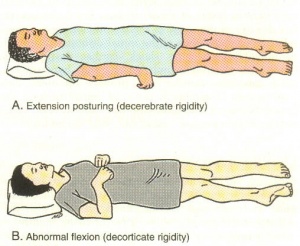Hypertonicity vs spasticity
Original Editors - Saeed Dokhnan
Top Contributors - Saeed Dokhnan, Laura Ritchie, Lucinda hampton, Admin, Evan Thomas, Scott Buxton, Kate Sampson, Kim Jackson and Aya Alhindi
Hypertonicity or Spastic Dystonia[edit | edit source]
Spasticity is a term that is often used interchangeably with hypertonia. Spasticity, however, is a particular type of hypertonia in which the muscles' spasms are increased by movement.
Muscle Tone[edit | edit source]
Tone is the resistance of muscles to passive stretch or elongation, basically the amount of tension a muscle has at rest. Normal tone is high enough to resist the effects of gravity in both posture and movement yet low enough to allow freedom of movement[1]
Hypertonia is resistance to passive movement, it is not dependent on velocity, can be with or without spasticity.
Spasticity is an increase in resistance to sudden , passive movement and IS velocity dependent. The faster the passive movement the stronger the resistance. Spasticity is considered to be a form of sustained efferent muscular hyperactivity, dependent on the continuous supraspinal drive to the alpha motor neuron.[2]
Decorticate and decerbrate rigidity are a form of spastic dystonia.
- Decorticate posture is a sign of damage to the nerve pathway in the midbrain, which is between the brain and spinal cord. The midbrain controls motor movement. Serious condition but not as severe as the below.
- Decerebrate posture is an abnormal body posture that involves the arms and legs being held straight out, the toes being pointed downward, and the head and neck being arched backward. The muscles are tightened and held rigidly. This type of posturing usually means there has been severe damage to the brain[3].
| [4] |
Spasticity[edit | edit source]
Spasticity is a velocity-dependent increase in muscle tone in response to passive movement. Pyramidal tract injury doesn't give rise to spasticity. Rather, the main symptoms are weakness and loss of dexterity which is greater in distal than in the proximal muscles. The pyramidal tract is the system which balances muscle tone.
| [5] |
Neural Component of Spasticity[edit | edit source]
- Dorsoreticulospinal tract (DRT) - has an inhibitory effect on MRT and VST
- Medial reticulospinal tract (MRT) and Vestibulospinal tract (VST) - have a facilitatory effect on extensor tone.
All three systems are thought to inhibit flexor reflex afferents responsible for flexor spasm.
| [6] | [7] |
References[edit | edit source]
- ↑ Hypertonia, clonus , & spasticity Pediatric Services Available from: https://www.pediatricservices.com/answers/005-hypertonia.htm (last accessed 29.11.2019)
- ↑ Clinical evaluation and management of spasticity, Jeffery et. al.2002
- ↑ M S Hershey Medical centre. Multimedia encyclopedia Available from: http://pennstatehershey.adam.com/content.aspx?productid=117&pid=1&gid=003300 (last accessed 29.11.2019)
- ↑ AriseandShineTherapy. What is Muscle Tone?. Available from: http://www.youtube.com/watch?v=YNnwf_XbRac [last accessed 29/08/16]
- ↑ brezzyana4's channel. Spastic Diplegia (Cerebral Palsy) 17 months old. Available from: http://www.youtube.com/watch?v=c-CV6dYNXsw [last accessed 29/08/16]
- ↑ Steffan Rasmussen. The Pathophysiology of Spasticity - Dystonia and its Difference From Spasticity [3/8]. Available from: http://www.youtube.com/watch?v=nann4fCB6HQ [last accessed 29/08/16]
- ↑ Steffan Rasmussen. The Pathophysiology of Spasticity - What Determine Muscle Tone and what Causes Spasticity [4/8]. Available from: http://www.youtube.com/watch?v=THPdi5KSVVk [last accessed 29/08/16]







